Gamification as a neurodidactic strategy to strengthen the learning of reading in third grade students of elementary education
DOI:
https://doi.org/10.51736/sa.v7iEspecial%203.264Keywords:
gamification, neurodidactics, readingAbstract
The topic addressed is gamification as a neurodidactic strategy to strengthen the learning of reading. Gamification is a novel strategy that involves neurodidactic elements and strengthens learning in order to overcome difficulties in educational processes. Neurodidactics today provides valuable information on how the brain processes information and learns, helping to design mechanical game activities that are aligned with the principles of brain functioning. The present work is elaborated for children of third year of basic education of the Jacinto Collahuazo Educational Unit who have presented difficulties in reading, which have been identified through classroom observation processes, interviews to teachers and students. However, with the scientific support of several authors, a brief study on gamification, neurodidactics and reading components was carried out in order to elaborate the scientific proposal that contains playful gamification strategies to solve the difficulties found in the students. Subsequently we have validated with experts to see the feasibility and relevance of the topic.
Downloads
References
Arteaga, V. (2022). La gamificación como estrategia neurodidáctica para incentivar la motivación escolar. https://repository.ces.edu.co/bitstream/handle/10946/6057/Tesis.pdf?sequence=1&isAllowed=y
Beteta, C. (2008). Relación entre la autoeficacia y el rendimiento. https://www.redalyc.org/pdf/551/55160304.pdf
Ferrer, R. & Fernandez, P. (2018). la gamificacion como herramienta docente del orientador en base a la neurodidactica. https://redined.educacion.gob.es/xmlui/bitstream/handle/11162/185349/v.78%20n.1%20p%20165-182.pdf?sequence=1&isAllowed=y
Gaitán, V. (2013). Gamificación: el aprendizaje divertido. https://www.educativa.com/blog-articulos/gamificacion-el-aprendizaje-divertido/
Herrera Jiménez, F. J. (2016). Sobre el enfoque lúdico en los procesos de enseñanza y aprendizaje de segundas lenguas. https://www.nebrija.com/revista-linguistica/sobre-el-enfoque-ludico-en-los-procesos-de-ense%C3%B1anza-y-aprendizaje-de-segundas-lenguas.html
INEC. (2012). 3 de cada 10 ecuatorianos no destinan tiempo a la lectura. https://www.ecuadorencifras.gob.ec/3-de-cada-10-ecuatorianos-no-destinan-tiempo-a-la-lectura/
Jara, W. (6 de 12 de 2019). Historia de la gamificación. https://matematicas69026909.wordpress.com/2019/12/06/historia-de-la-gamificacion/
Josende, K. (2018). Gamificación en la educación/historiadelagamificacion. https://es.wikibooks.org/wiki/Gamificaci%C3%B3n_en_la_educaci%C3%B3n/historiadelagamificacion#:~:text=HISTORIA%20DE%20LA%20GAMIFICACI%C3%93N%3A,el%20m%C3%A9todo%20de%20la%20recompensa.
Méndez, N. (2009). ¿Qué es la enseñanza? http://www.nelsonmendez.com/2009/11/que-es-la-ensenanza.html
Mora, F. (2022). La Neuroeducacion en el Aula.
Osorio, L. (2021). Elementos del proceso de enseñanza – aprendizaje y su interacción en el ámbito educativo. https://revistas.unibe.edu.ec/index.php/qualitas/article/view/117/124
Pertegal, A. & LLedo, M. (2019). Gamificación en el aula a través de las TIC . https://dialnet.unirioja.es/servlet/articulo?codigo=7376150
Reglero, J. (2020). La historia de Nintendo desde sus orígenes hasta hoy. https://areajugones.sport.es/videojuegos/la-historia-de-nintendo-desde-sus-origenes-hasta-hoy/
Sayalero, L. (29 de 11 de 2017). La gamificación. ¿Qué ventajas y desventajas nos ofrece la gamificación?: https://colavoro.com/blog/cultura-empresarial/gamificacion/
Tenesaca, M., & Criollo, F. (10 de 2020). La gamificación como estrategia didáctica para el fortalecimiento de la lectura . http://repositorio.unae.edu.ec/bitstream/56000/1646/1/a.%20Documento%20de%20Integraci%C3%B3n%20Curricular%20Gamificacion.pdf
Torres, & Granado. (2014). Gamificacion dentro del contexto escolar y lectura. http://repositorio.unae.edu.ec/bitstream/56000/1646/1/a.%20Documento%20de%20Integraci%C3%B3n%20Curricular%20Gamificacion.pdf
Universidades, S. (2022). Ventajas de la gamificación en el aula: qué herramientas utilizar y cómo aplicarla. https://www.becas-santander.com/es/blog/gamificacion-en-el-aula.html#:~:text=de%20la%20mano.-,%C2%BFEn%20qu%C3%A9%20consiste%20el%20concepto%20de%20gamificaci%C3%B3n%20en%20el%20aula,el%20propio%20desempe%C3%B1o%20del%20trabajo.
Valenzuela Alfaro, M. Á. (2021). Gamificación para el aprendizaje. Una aproximación teórica sobre la importancia social del juego en el ámbito educativo. http://portal.amelica.org/ameli/journal/248/2482275001/html/
Vasquez, & Campillo. (2021). La gamificacion como estrategia neurodidactica para incentivar la educacion . https://repository.ces.edu.co/bitstream/handle/10946/5413/1067899662_2021.pdf?sequence=1
Published
How to Cite
Issue
Section
License
Copyright (c) 2024 Grace Margarita Narváez Revelo, Jasmín Carolina Morales Enríquez, Edgar Ezequiel Luna Sánchez, Giselle Aurelia Rodríguez Caballero

This work is licensed under a Creative Commons Attribution-NonCommercial-ShareAlike 3.0 Unported License.






















































